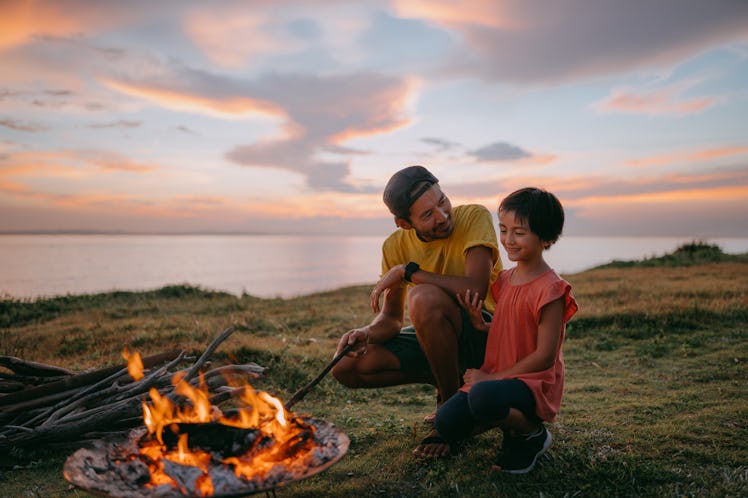I Parented Like A German And Wound Up Playing With Fire
Germans are less about laissez-faire parenting than they are about letting kids take risks, which is a much more inspiring way to live.

I’m big on autonomy. Or I thought I was anyway. I prefer to be in the background as my two boys play. I send them outside unsupervised. I ask them to find their own solutions to problems, and when they battle — as brothers do — I don’t intervene until someone is gasping raggedly and choking on tears. But as my 4-year-old, standing at the counter atop a wicker chair, wrapped his hands around the hilt of a large kitchen knife and hacked into a section of Kielbasa, my strained expression was a testament to my American-ness. I am not German.
As laid out in author Sara Zaske’s best-selling new parenting book, Achtung Baby: An American Mom on the German Art of Raising Self-Reliant Children, it’s clear that Germans are operating on a higher level in fostering kinder-autonomy. Like me, they are slow to step in as kids live their wild and sometimes risky kid lives. But the autonomy I give my children is largely in their play. Germans proactively give kids opportunity to experience risk and danger.
Risk and danger are actually cultivated in “forest schools” where German kids are given pocket knives and allowed to play with fire. It might come in the form of “adventure playgrounds” filled with sharp tools and junk materials an American parent would consider life-threatening. And it also might come in the form of sous-chef-ing the hell out a meal. Buying into the Teutonic hype, I decided to take some cues and let my younger son handle some pointy objects.
In retrospect, I should have given him a more manageable knife. The previous night, I’d given his older brother a sharp steak knife to ease his own cutting woes, and that had gone swimmingly. But maybe plopping the six-incher into the youngest’s hands was an act of hubris.
It was unwieldy to be sure, but I’ll be damned if his mixture of glee and caution didn’t manage to stifle my desire to grab his hands and stop the obvious madness. I gave some calm verbal suggestions (“Keep your other hand away from the blade”) as he managed a sloppy vivisection of encased meat. I stopped short of allowing him to make some fillet-style longitudinal cuts, however, considering even I, a grown-ass man with years of experience, was still shaky with the technique.
Still, we came back to the cutting board over the next few days. I found the 4-year-old capable of real concentration. He quickly understood that this was not an activity to pursue recklessly. He adjusted his grip and angle of attack. I was able to say less and less.
The experience worked well enough for me to take the danger up a notch by letting my kids go all in on building (and experimenting with) a fire.
When I told them we were going to build said fire, what they heard was, “Poppa is going to build a fire.” But when it sunk in that, in fact, they were going to build the fire, bedlam ensued. I’d jacked into something primal. So primal that their shirts came off and they cleaned the playroom where the fireplace is located in half the time it normally takes. So I put them to work shredding cardboard boxes and throwing them onto the fireplace grate for kindling. They growled in deep macho tones as they did so.
“I need a nickname,” my 7-year-old said. “I want to be called the Chicago Tiger.”
“Okay,” I replied as I lit the end of the long strip of cardboard he was holding with a lighter.
A flame leaped up at the end of the cardboard strip and he thrust it into the pile of cardboard under a couple of logs. The conflagration erupted, and my boy quickly tossed the burning strip on top of the logs, feeling the heat and letting out a long, low exclamation.
A offered a single ground rule: At no point does the flame ever come out of the fireplace. Then I stepped back and let them play.
I expected anarchy. I expected my boys to throw flaming logs back and forth while laughing like cartoon villains. What I got was far more measured. My oldest burned more long strips of cardboard, observing how different parts burned like a naturalist noting the behavior of an animal. He marked the sounds of the fire and thought about why it whooshed. He hypothesized about how different sizes of cardboard would burn and then tested his hypotheses. He burned different types of paper and wondered at the way they curled and blackened.
And it all made sense. As American parents, we are deeply risk-averse. But an aversion to risk is antithetical to discovery. And discovery feels significant. Discovery makes a kid feel smart and behave more intelligently.
I thought I had been giving my kids freedom to learn, explore, and discover on their own. But I hadn’t been. Not really. Because I’d managed away most of their risk. They could go outside alone, but not past the yard. Not to the creek or meadow. Not out of eyesight. They could cook, but not at the stove. Not with the sharp knives. They could be at the fire, but they could not get too close. They certainly couldn’t stir the embers or throw something into the flames.
And now that they had the opportunity, they were showing me their capacity for wonder and discovery.
My wife, who had scoffed at the fire suggestion initially, watched our boys from the couch. “I think we can take the fireplace doors off,” she remarked. That’s something we’d always wanted to do, but hadn’t for “safety.”
My wife is German by blood and temperament. Now, I am too. At least a little.
This article was originally published on